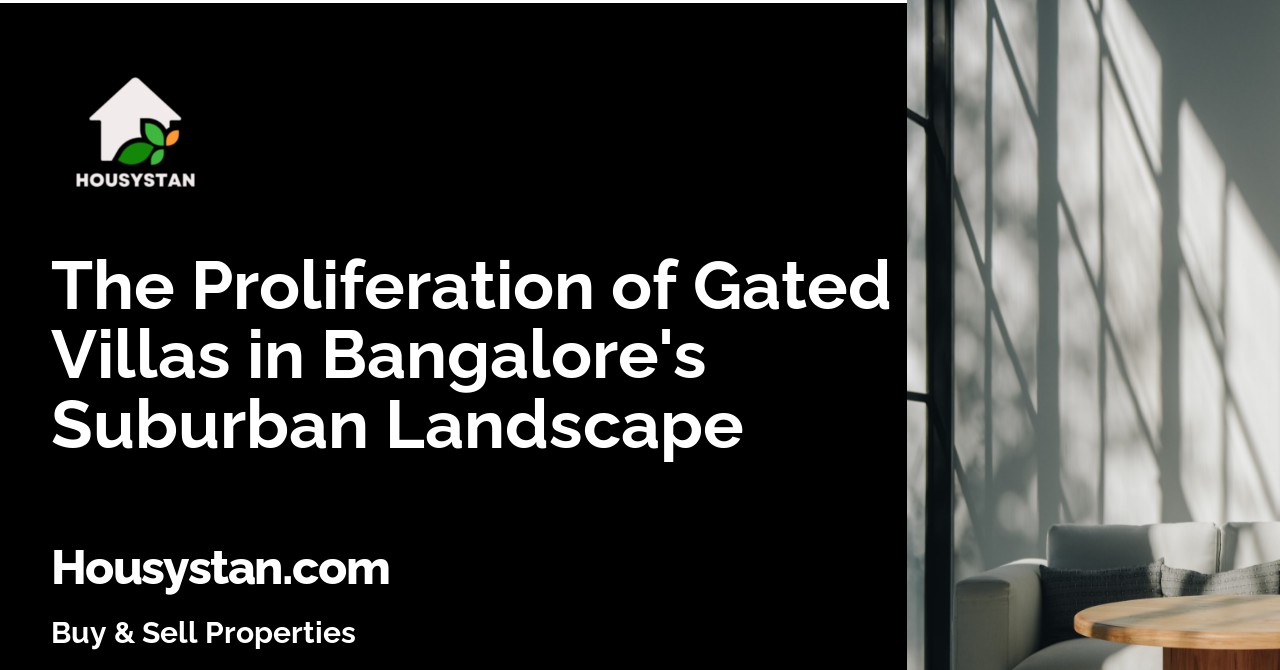The Proliferation of Gated Villas in Bangalore's Suburban Landscape
Read latest blogs and articles from Housystan

The Information mentioned here was last updated on:
17/1/2026The Proliferation of Gated Villas in Bangalore's Suburban Landscape
Bangalore, known as the Silicon Valley of India, has long been a hub for IT professionals, startups, and tech giants. As the city continues to expand, there has been a noticeable trend in its suburban landscape: the rise of gated villas. These luxurious accommodations have become the ultimate dream for many seeking tranquility and exclusivity, away from the bustling city center. Let's explore the phenomenon of gated villas proliferating across Bangalore's suburbs.
Understanding the Rise of Gated Communities
- Verified Tenants/Buyers
- Unlimited Property Listing
- Zero subscription/charges fee
Gated communities offer a combination of security, community living, and lifestyle amenities. Unlike traditional housing, they provide a sense of exclusivity that appeals to high-income groups and expatriates. As urbanization accelerates, many residents seek refuge in these serene environments, leading to their rise in the suburban outskirts of Bangalore.
A crucial factor driving this trend is the search for a better quality of life. Bangalore's urban core is often characterized by traffic congestion, pollution, and a hectic pace of life. Suburban gated villas, in contrast, offer lush greenery, open spaces, and well-maintained facilities. This shift partly stems from the desire to balance the benefits of city life with the tranquility typically found in rural settings.
Prime Locations for Gated Villas
The emergence of gated villas is especially prevalent in areas like Whitefield, Sarjapur Road, and Devanahalli. Whitefield, once a quiet settlement, has transformed into a preferred residential location due to its proximity to tech parks. Similarly, Sarjapur Road has gained popularity because it connects well to major parts of the city and hosts numerous IT companies. Devanahalli, on the other hand, appeals to those who want to reside near Kempegowda International Airport, offering convenience for frequent travelers.
These locations illustrate how strategic placement is crucial for the success of gated communities. Developers strive to build in areas that provide a balance of accessibility and remoteness, offering both privacy and easy commutes to work hubs.
Features and Amenities of Gated Villas
The allure of gated villas extends beyond location. They come loaded with features and amenities that cater to varied lifestyles. A typical gated villa offers ample living space, elegant design, and modern conveniences. Common amenities include swimming pools, clubhouses, gyms, jogging tracks, and landscaped gardens.
Moreover, these communities often offer exclusive facilities such as tennis courts, playgrounds, and even golf courses. Such amenities promise a resort-like living experience, making them highly attractive to families and individuals looking for more than just a place to live.
Security is another critical aspect that draws people to gated villas. Round-the-clock security personnel, CCTV surveillance, and secure entry and exit points ensure that residents feel safe at all times. This heightened sense of security is especially appealing to families with children and retirees.
The Role of Real Estate Developers
Real estate developers play an instrumental role in the proliferation of gated villas. Leading developers in Bangalore have recognized the demand for premium housing and are constantly innovating to meet this need. Their projects are often marketed with an emphasis on luxury, sustainability, and cutting-edge design.
Developers also leverage technology to enhance the living experience. Smart home features, energy-efficient solutions, and environmental considerations are increasingly being integrated into villa designs. These innovations appeal to the tech-savvy population of Bangalore, reinforcing the city's image as a forward-thinking metropolis.
Economic Impacts on Local Communities
The growth of gated villas has significant economic implications for the surrounding areas. These developments boost local economies by creating jobs during both the construction and operational phases. The influx of affluent residents also supports local businesses, from retail outlets to service providers.
However, this trend can also lead to challenges, such as rising property prices, which may impact affordability for local populations. As demand for suburban villas increases, so does the cost of land and housing in these regions.
Environmental Considerations and Challenges
While gated villas offer numerous personal and economic benefits, they also have environmental impacts that warrant consideration. The construction of new communities often involves clearing land, which can disrupt local ecosystems. Developers must navigate these concerns by adopting sustainable practices and ensuring environmental regulations are upheld.
Efforts to mitigate ecological impact include designing energy-efficient buildings and incorporating green spaces into the community layout. Developers are increasingly turning to eco-friendly construction materials and renewable energy sources to minimize their carbon footprint.
Future Prospects in Bangalore's Real Estate Market
The future of gated villas in Bangalore's suburban landscape looks promising. As more people prioritize lifestyle and wellness, the demand for such accommodations is anticipated to grow. The integration of smart technology, sustainability, and luxury will further cement their appeal.
Additionally, ongoing infrastructure developments, such as new roads, metro lines, and other connectivity projects, are likely to enhance the desirability of suburban living. These improvements will make it easier for residents to balance work and leisure, adding further incentive to invest in these communities.
Conclusion
The proliferation of gated villas in Bangalore's suburban landscape represents a significant shift in housing preferences. Fueled by the desire for a higher quality of life, residents are increasingly opting for the security, amenities, and serenity that these developments offer. As this trend continues, it promises to reshape the city's periphery, offering a blend of comfort, luxury, and sustainability.